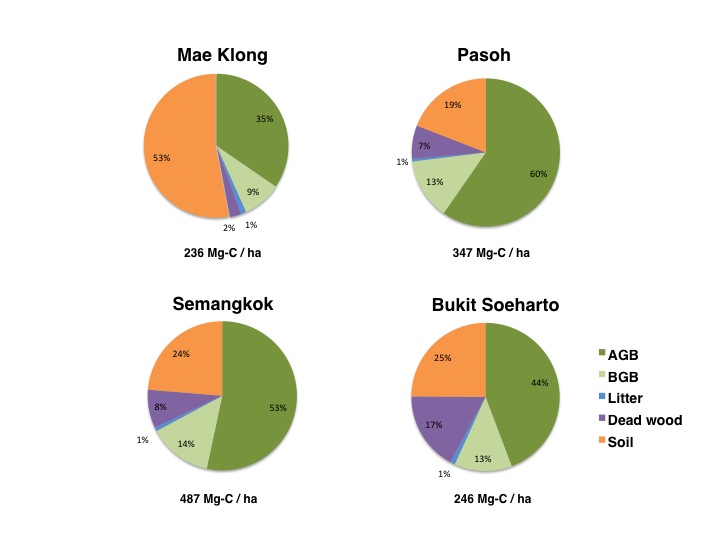Data Summary
Cross-site comparison of five C pool in tropical forests
Profiles of the research plots
| Mae Klong | Pasoh | Semangkok | Bukit Soeharto | |
|---|---|---|---|---|
| Country | Thailand | Malaysia | Malaysia | Indonesia |
| Forest type | Tropical dry forest (Mixed deciduous forest (MDF)) | Tropical rain forest (Lowland dipterocarp forest) | Tropical rain forest (Hill dipterocarp forest) | Tropical rain forest (Lowland dipterocarp forest) |
| Plot size | 4-ha | 6-ha | 6-ha | 1-ha |
| Established year | 1992 | 1994 | 1992 | 1988 |
| Main disturbance agent | Fire | Wind throw and storm | Wind throw and landslide | Human activities, drought and fires |
| Severe disturbances occurred during monitoring? | No | No | No | Yes |
Data sources
| Mae Klong | Pasoh | Semangkok | Bukit Soeharto | |
|---|---|---|---|---|
| Aboveground biomass (AGB) | Original tree census data in 2010 | Original tree census data in 2010 | Original tree census data in 2011 | Original tree census data in 2010 |
| Belowground biomass (BGB) | Original tree census data in 2010 | Original tree census data in 2010 | Original tree census data in 2011 | Original tree census data in 2010 |
| Litter layer | Takahashi et al. (2011) | Yoda (1978) | Original data | Original data |
| Dead wood (CWD) | Original data | Yoda (1978) | Original data | Original data |
| Soil (0-30 cm) | Takahashi et al. (2011; unpublished data) | Yoda (1978), Yamashita et al. (2003) | Tange et al. (1998), Sato et al. (in press) | Original data |
Cross-site comparison
The carbon stock values from the five carbon pools varied across the monitoring plots. High carbon stocks, which were more than 300 Mg-C/ha, were estimated in Semangkok and Pasoh. Both plots were similar in composition in carbon pools: more than 60% of carbon stocks retain within aboveground biomass. In Semangkok, large size class trees of Shorea curtisii, dominated especially on the ridge, contributed to high aboveground biomass.
In Mae Klong, the soil carbon pool contained nearly one third of the total carbon stock. Dead wood stocks showed small values (i.e. 3% of total carbon pools) due to low tree biomass and frequent fire disturbances. On the other hand, the impact of severe fires and subsequent drought caused relatively high dead wood stock and low aboveground biomass in Bukit Soeharto.

- Sato T et al. (in press) Kanto Journal of ForestResearch (in Japanese with English summary)
- Takahashi M et al. (2011) Soil Science and Plant Nutrition 57(3):452-465
- Tange T et al. (1998) Journal of Tropical Forest Science 10: 398-409
- Yamashita T et al. (2003) Soil and belowground characteristics of Pasoh forest reserve. In Pasoh: ecology of a lowland rain forest in Southeast Asia. Springer-Verlag, Tokyo, pp. 89–109
- Yoda K (1978) Malayan Nature Journal 30 (2): 229-251